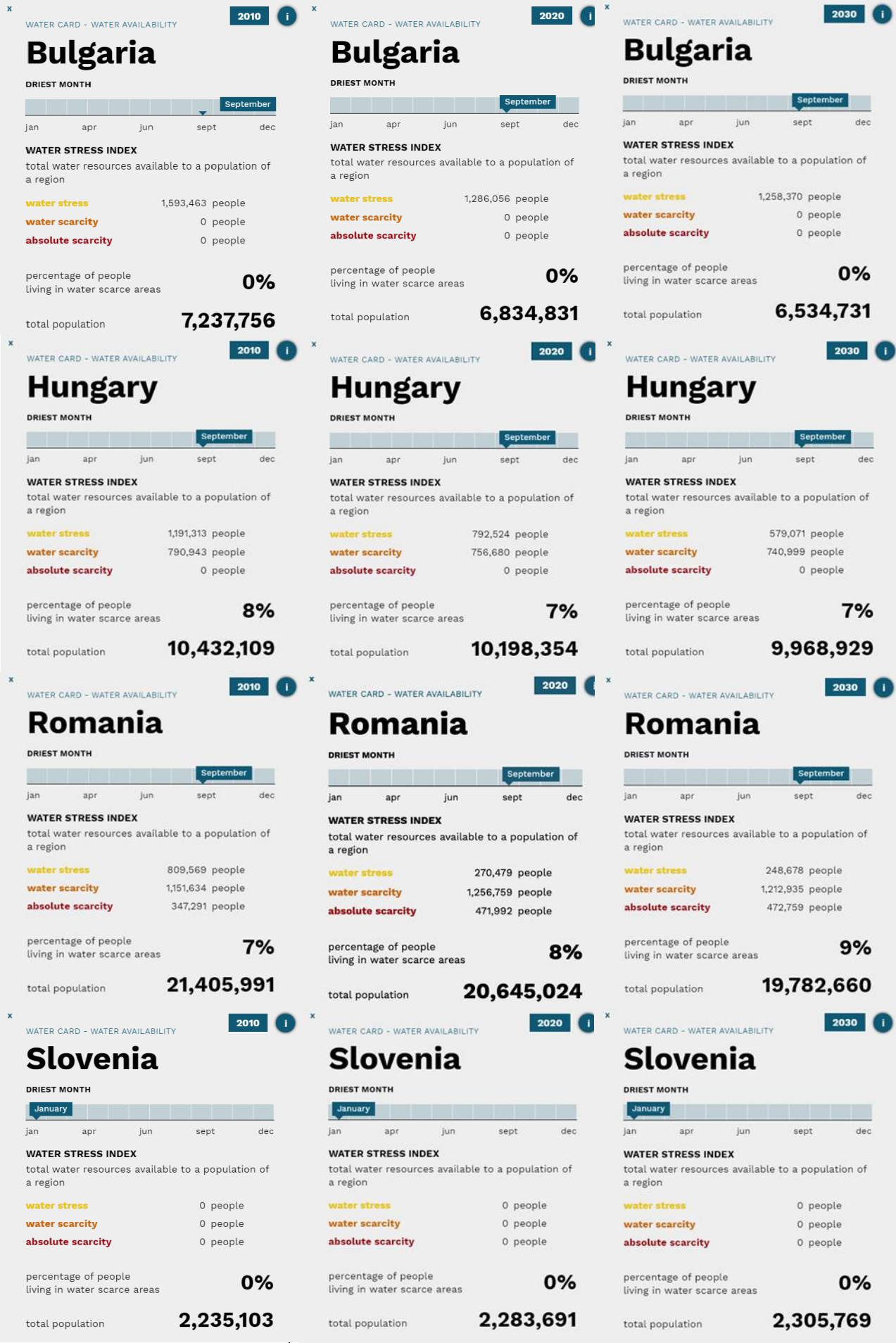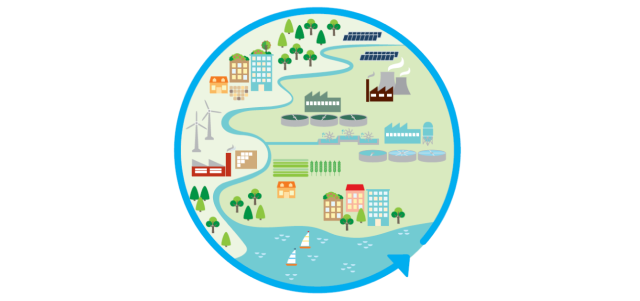The GWP CEE “Water in the Circular Economy“ Taskforce has published its background paper on the challenges and solutions to implementing the principles of circular economy in the sustainable water management. The Taskforce consists of researchers and practitioners from four countries – Bulgaria, Hungary, Romania and Slovenia. Its aim is to establish a common understanding of circular economy principles in the water sector of the countries of Central and Eastern Europe and to boost their implementation in the Danube region.
The paper deals with current situation of implementation of circular economy concept in the water sectors of the four countries. It strives not only to describe the state of play but the most important objective is to reveal what are the major gaps and how they can be filled by future research projects and programmes.
The paper's summarised results collected from questionnaires filled by the experts in the said countries as well as information and data from other studies and datasets of OECD, Eurostat and national sources.
The potential benefits of implementation of circular economy concept in the water sector tie with savings in water supply and needs of construction and maintaining of expensive infrastructure of water services, further utilisation of sludge in agriculture, solving problems with water shortages and risk of floods. It also helps diminishing other types of harmful emissions.
The most familiar circular economy processes are agro-industrial wastewater purification, renewable energy and compost production. According to the OECD (2020), cities and regions identify the waste sector as key in their progress towards a circular economy (98%), followed by the built environment (75%), land use and spatial planning (70%), food and beverages and water and sanitation (65%).
Recycling and reuse are central to a circular economy approach and offer a strategy to improve water supply by managing wastewater better. Water reuse faces numerous barriers, ranging from public perception to pricing and regulatory challenges that could be addressed more effectively though a wider circular economy perspective. An integrated, interdisciplinary and holistic approach would facilitate the application of water reuse as part of an integrated water management strategy that could be significantly accelerated in the context of a circular economy. Such strategy should also ensure the safety of water reuse, and therefore apply water quality standards appropriate to the specific use, but also ensure adequate and reliable operation of water reuse systems and appropriate regulatory enforcement.
A closer look on surveyed countries
Freshwater resources per inhabitant are considered an important indicator for measuring the sustainability of water resources. To this end, water stress index has been elaborated that presents total water available to a population of a country. This indicator has been developed by the United Nations and widely used by different institutions and purposes. Water scarcity clock provides information for not only water availability in the past but also deliver forecast for next decades.
In Bulgaria there is no population living in water scarce areas in 2010, 2020 and 2030 (Graph below). Nevertheless, 1.6 million of population were exposed to water stress in 2010. The number was reduced to 1.3 million in 2020 and expectations are that in 2030 there will be 28,000 less.
Hungary also experiences problems with population living under water stress. Their part of total population is 8% in 2010 and 7% in 2020 and 2030 (Graph below). There are no people living in absolute water scarcity areas right now, but 1.5 million in 2020 and 1.3 million in 2030 were and will be under water stress and potential water scarcity.
Romania has the highest number of populations living in water scarce areas among the four countries (Graph below). In 2010, the results presented 7% of population, in 2020 it was 8%. It is expected that in 2030, 9% of population will live in these areas. The most dramatic is situation with population in absolute scarcity. Their number was almost 350,000 in 2010, 472,000 in 2020 and even little bit more in 2030. More than 1.5 million Romanian citizens lived in water stress and water scarcity in 2020. There will be 66,000 less in 2030.
Slovenia is the best-positioned country among the four. The country has no problems with water stress and water scarcity (Graph below). No Slovenian citizen lives under water stress and there are no expected changes in this situation in the near future.

Source: Water Scarcity Clock
Water pollutants on a larger scale
Water pollutant releases along with other factors shape the ecological status of river basins. The picture depicting the current state of European water bodies not in good ecological status or potential in river basin districts is presented below. From the Taskforce's survey sample, the worse situation is in Hungary where more than 90% of water bodies are not in good ecological status or potential. This is followed by Bulgaria with 40-50% (North) or 50-70% (South). Romania and Slovenia are more homogeneous. In both countries, 30-40% of water bodies are not in good ecological status.

Source: EEA
The next steps
The Taskforce studies the most important problems in the water sector in the four CEE countries that could be tackled by the circular economy approach. Despite the new EC circular economy action plan adopted in March 2020, one can conclude that there are little incidences in the investigated countries relevant to implementation of circular economy principles.
The study reveals market niches in these countries where different initiatives are more suitable to be launched in near future:
-
The implementation of energy efficiency and non-revenue water reduction programs that have recovered the investments in a short period of time while saving water and energy and increasing the amount of people with access to services.
-
The recovery of resources from wastewater and the creation of new revenue streams by using for own needs or selling energy, water, and fertilizers to cover operating costs.
-
The application of circular economy and resiliency principles in long-term strategies to become carbon neutral, recover resources from water and preserve the environment while providing water services.
-
The assessment of the full potential of the existing infrastructure, resulting in huge savings in capital investments.
What is Circular Economy?
The EC adopted the new circular economy action plan in March 2020 (EC, 2020). It is one of the main building blocks of the European Green Deal. The expectations are that the EU’s transition to a circular economy will reduce pressure on natural resources and will create sustainable growth and jobs in EU countries. It is already proven that half of total greenhouse gas emissions and more than 90% of biodiversity loss and water stress come from resource extraction and processing (EC, 2020).
The main idea of circular economy is to maintain the value of products and materials as long as possible. It is the opposite of a throw-away culture or society. Waste and resource use are minimised and when a product reaches the end of its life, it is reused to create further value. The concept of circular economy is based on three principles:
-
Design out waste and pollution
-
Keep products and materials in use
-
Regenerate natural systems.
World Water Day 2022
This year groundwater is the main focus of World Water Day. Groundwater is invisible, but its impact is visible everywhere. Out of sight, under our feet, groundwater is a hidden treasure that enriches our lives. Almost all of the liquid freshwater in the world is groundwater. As climate change gets worse, groundwater will become more and more critical. We need to work together to sustainably manage this precious resource. Groundwater may be out of sight, but it must not be out of mind, say the UN-Water organizers of the World Water Day.
